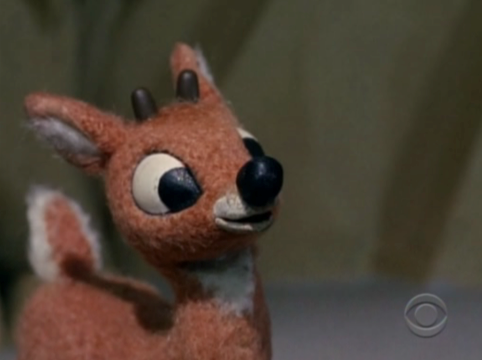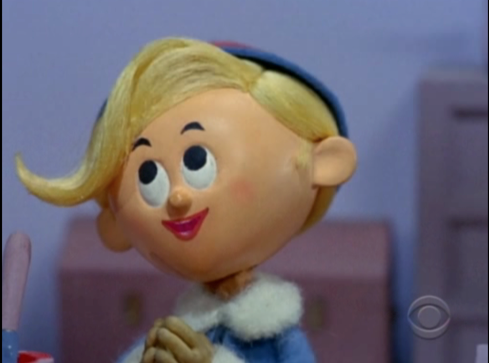A Merry Queer Christmas: Queering Rudolph, the Red Nosed Reindeer
These days it seems easy to queer the 1964 CBS Christmas classic. Rudolph was created when gayness as identity was rarely represented on screens, instead shunned off into the shadowy world of coded meanings waiting to be activated by knowing readers or “appearing” as semiotic excess waiting to be queered through the practice of camp. Yet, as Alexander Doty argued, queerness isn’t always a waiting to be discovered property of a text, and sometimes the heterosexual reading is the alternative one. With each passing Christmas, the signs of queerness grow more plentiful and overwhelm any other understanding of Rudolph.
So, let’s examine the evidence – the moments of coded meaning and excess that indicate a queer longing for acceptance and love. The first part of our story introduces us two queered misfits, Rudolph and Hermey, both struggling with forms of difference. Born to the Donners, young buck Rudolph is a source of pride until Mr. Donner sees his son’s bright, shiny red nose. While generally a benevolent figure of myth, this Santa does not offer a moment of Lady Gaga acceptance for little monster, Rudolph. Faced with the possibility that Rudolph will not ascend as a member of Santa’s sled team, Donner decides to make him a “normal little buck,” hiding his “nonconformity” with an uncomfortable nose cap; i.e. Rudolph is closeted.
His outing comes while playing reindeer games. When young doe Clarisse winks and flirtatiously tells him he is cute, Rudolph flies, falls, and loses his nose cover. While his male peers and authority figures mercilessly tease him, Clarisse is pleased to meet the real Rudolph and assures him he is wonderful as is. Lest we assume that Clarisse somehow secures Rudolph’s heterosexuality, the song to encourage him, “There’s Always Tomorrow,” is an obvious riff on the queer camp classic, “Somewhere Over the Rainbow.”
“There’s Always Tomorrow”
Then there is Hermey, the elf who wants to be a dentist. If Rudolph is forced to hide his difference, Hermey is determined to embrace his, despite an elf boss who berates and belittles him for his strange desire. It would take someone with more fluency in psychoanalysis to make sense of the aural fixation at work , but his blonde swoosh of hair, red lips, and indeterminate voice, at once childish and fey, put him somewhere in the vicinity of the sissy stereotype. While his fellow elves sing their elf jingles dressed up in gender appropriate pink and blue, Hermey practices his craft. This misfit runs away in search of his own better tomorrow.
In the background is the Abominable Snow Creature, more often heard than seen, with a ferocious growl and imposing appearance. He hates everything about Christmas. The Abominable functions less as a character than as a placeholder. If Christmas stands in for a heteronormative world order, he is the necessary remainder, the excess that secures the center of this Christmas world.
Hermey and Rudolph meet and the young queer pair of misfits find themselves in a cold, hostile world, under constant threat by the Abominable, who finds them thanks to Rudolph’s shiny nose. It is on the road that they meet gold prospector, Yukon Cornelius. With his handlebar mustache and general macho tendencies, he too carries coded signifiers of gayness. But unlike our young friends, Yukon seems entirely unfazed by this, indicated both by his relationship with his pickaxe, and casual dismissal of the Abominable as a mere “Bumble.” Fleeing the Abominable, our newly queer trio ends up on the Island of Misfit Toys, greeted by the lisping, depressed Charlie in a Box who explains that they are toys with a difference, shunned by children and gathered into their own community of comfort. Here our trio is granted brief asylum, but not permanent residence in their newfound queer community.
Island of Misfit Toys
It is then that Rudolph decides to go it alone in order to protect his friends from the danger he brings them. He heads off to face his greatest fear – the Abominable, i.e. the reality of his difference. In a scene that terrified me as a child and still rings with a sense of despair, young Rudolph stands alone on a sheet of ice and heads back to the mainland while the Abominable roars in the background.
As we reach the climax of the story, a grown up Rudolph returns home only to find that the Donners and Clarisse have been taken captive by the Abominable. While Rudolph tries his best, it is actually Hermey and Yukon who come to the rescue. The latter’s utter disregard for the “Bumble,” combined with Hermey’s newfound talents as a dentist, spell his end. It is telling that the Abominable loses his power to inspire fear at the moment that our queer pair make peace with their own differences and return to Christmas town. To my mind the end can be read in a couple of ways. On one hand, we can see that the Abominable simply ceases to be monstrous as queerness itself loses its negative purchase. As our queer trio returns as heroes who have vanquished the horror of queerness by finding first self, then group acceptance, it ends with a message akin to It Get’s Better. On the other hand, I sometimes wonder why our queer trio have so much invested in Christmas. Our queer denizens find acceptance as useful citizens reproducing Santa’s patriarchal, authoritarian, gender normative world order, leaving aside their bonds with each other in order to assimilate back into normal.
See, easy. Indeed, a quick web search yields a number of pop culture stories and web sites wondering if Rudolph is gay, especially since the mid 2000s. If in 1964, Rudolph could only whisper its queer longing for acceptance through subtext, today, Rudolph and Hermey’s queer tale of acceptance could easily be a story arc on Glee or any ABC Family show. Now the subtext (if it ever was) is simply text.





